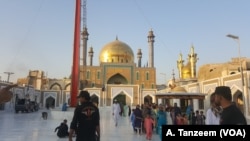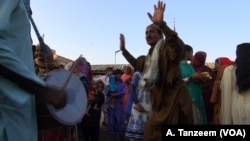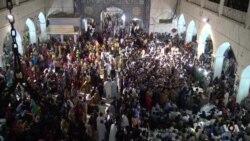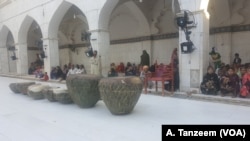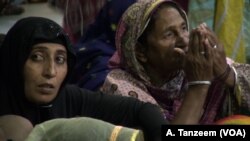The woman danced with reckless abandon, her head bent forward, moving rhythmically left to right with the drum beat, her long, black, untied hair creating an arc in the air as it flew back and forth. Another woman, probably a relative or a friend, tried to throw a scarf over her head, but gave up after it kept falling off.
The scene could have caused an uproar in another part of Pakistan, a conservative country where women in public are expected to be subdued and not draw attention to themselves, but not here.
This was the shrine of Lal Shahbaz Qalandar, a famous 13th century Sufi saint. For the last 700 years or so, legend has it, every night around sunset, drummers beat large drums, called naubat, as people — men and women, young and old — danced to their beat. The dhamaal, as the dance was called, is a form of devotion similar to the whirling of the Turkish dervishes.
The shrine, based in the city of Sehwan Sharif, in the Sindh province of Pakistan, is a magnet for people of all faiths. Hindus, a large minority in the province, revere Qalandar just as much as the Muslims of both Shiite and Sunni sects. Folklore says "Daata," a nickname for the saint, can cure infertility in women, who come in droves to pray for children.
"This is the door of a saint; you find love here," said Ghulam Sarwar Langha, the manager of the shrine. "Everyone is welcome; no one is turned away."
Last February, soon after the dhamaal started, the walls of the shrine shook following a loud blast. A suicide bomber had detonated explosives in his jacket. At least 80 people, including many women and children, were killed.
The attack, one of many in Sindh on various holy places in the last few years, was one of the indicators that the inclusive, tolerant culture of Sindh was changing, according to anthropologist Zaigham Khan.
"Not only are we seeing incidents of terrorism in Sindh, we are seeing Sindhi youth involved in them, which means they are joining militant groups," Khan said.
WATCH: Pakistan's Sindh Celebrate the Other, But for How Long?
Forced conversions?
Naureen Laghari, from Hyderabad, Sindh, a medical student and the daughter of a university professor, left home to join Islamic State. After her arrest in April of this year, she confessed that she was going to be used as a suicide bomber.
Similarly, while the suicide bomber at the Qalandar shrine was believed to be from Afghanistan, the man who allegedly helped facilitate the attack, Nadir Ali Jakharani, alias Murshid, was from a small village in Sindh called Kandhkot.
The trend has worried human rights activists who say space for minorities in the province is shrinking.
Almost 90 percent of Pakistan's Hindus live in Sindh. When the country separated from India in 1947, the Hindus of another province, Punjab, migrated to India while the ones in Sindh mostly stayed put. Slowly, some of them are choosing to leave.
"The main reason is that our minor girls are being kidnapped and forced to change their religion, often to marry a Muslim boy. This fear is forcing many parents to leave the country," said human rights activist Kapil Dev, a Hindu.
The Muslim clerics involved in such conversions of religion deny that the rituals are forced.
"The girls who come to us are mature," said Mian Abdul Haq, alias Mithu, a politician and influential cleric. "Within hours of their arrival, we call their parents so they can talk to their daughters ... offer them to come meet them. If the girls still refuse to go, as Muslims we then provide them protection."
Historically, anthropologist Khan said Sindh was always more spiritual than religious. "Now we see the spirituality being replaced by an orthodox religiosity."
Religious schools
One of the factors leading to this change, according to human rights activists, local journalists, and historians, is the spread of religious schools, known as madrassas, in Sindh, as they have in the rest of the country.
Until the late 1970s, the number of madrassas in Pakistan was under 1,000, according to historian Ilhan Niaz. Then the state, under the rule of military dictator Muhammad Zia ul-Haq, started to pour resources into and patronize a particular, orthodox sect of Islam, the Deobandis.
"By the time Haq died, the number of madrassas in Pakistan had ballooned to around 10,000," said Niaz. Most of them belonged to the Deobandi school of thought.
"In Pakistan, unfortunately, the orthodox form of Islam is very sectarian, and is based on differences, and conflict," said Khan.
The conflict was perpetuated by an Islamic revolution in Iran, followed by a proxy war of influence between Iran and Saudi Arabia in the region.
"You saw a polarization happening all over the country, including Sindh," Niaz said.
Today, numbers reported in local media suggest Sindh alone has around 10,000 madrassas.
The exponential growth has also been facilitated by the state's failure to provide citizens with the basic necessities, like education or health care, although the Sindh government claims it has worked to fill those gaps.
Until now, the centuries-old spirit of Sindh has resisted the schisms. The day after the deadly attack on the Qalandar shrine, the musicians beat their drums and people danced again. But will they dance for another 700 years?




